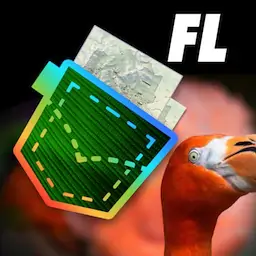"Sunset over the preserve, Big Cypress National Preserve, 2015." by U.S. National Park Service , public domain
ButterlfiesBig Cypress |
featured in
| National Parks Pocket Maps |  | |
| Florida Pocket Maps |  |
Date: _______________
Time: ________
Location: _____________________________
Weather: ______________________________
Observers: _____________________________
INDEX
C -Common (Present in the proper habitat and
season)
U -Uncommon (occasionally present in proper
habitat and season)
R -Rare (seldom present in suitable habitat; few
records)
S-Stray (strays from local areas)
X-Extirpated in the Preserve
Each species was indexed according to its
abundance in the Preserve, not on its likelihood of
being observed. If you see any unusual butterflies
please advise Preserve staff at the Visitor Center and
fill out a wildlife observation card or write to: Big
Cypress National Preserve, Attn: Wildlife Biologist,
33100 Tamiami Trail East, Ochopee, FL 34141.
Please be as specific as possible and remember
that your reported observations are important and
appreciated.
Big Cypress Butterflies and food sources
Top: Aster (eaten by Dainty Sulphurs
and Pearl Crescents), Little Yellow
butterfly, Wild Petunia (eaten by
Malachites, White Peacocks, and
common Buckeyes).
Bottom: Painted Lady lands on a
Blanket Flower, Thistle (eaten by
Painted Ladies), Dainty Sulphur lands on
a Spanish Needle—a food source for the
butterfly along with Aster/Daisy plants.
Cover page: Queen butterflies are one
of the mimics of Monarch butterflies.
Top row: Photos courtesy of Jan Shirey, NPS/VIP; Bill Perry; and Devon Cotsamire,
Bottom row: Photos courtesy of Gustave Pellerin, Jan Shirey NPS/VIPs, and Ron Nuehring
Cover page: Photo courtesy of Gustave Pellerin, NPS/VIP
Pipevines (Aristolochia species)
Paw-paws (Asimina species)
Carrot/Parsley Family, wild and cultivated
Rue Family, several Zanthoxylum species
Sweet Bay (Magnolia virginiana)
Laurel family, Swamp Bay, Red Bay
Swamp Bay, Red Bay
Caterpillar Food (Plant)
R
R
R
U
C
U
C
Virginia Pepper-grass
Saltwort, Virginia Pepper-grass
Index
U
C
Clover, white sweet clover, other legumes
Senna species
Senna species
Blackbead, Wild Tamarind
Several small weedy legumes and vetches
Partridge peas
Senna and Chamaecrista species
Aster/Daisy family, esp. Spanish Needles
Scientific Name
SWALLOWTAILS
___Polydamas Swallowtail
___Zebra Swallowtail
___Black Swallowtail
___Giant Swallowtail
___Eastern Tiger Swallowtail
___Spicebush Swallowtail
___Palamedes Swallowtail
R
C
R
C
C
C
R
U
Battus polydamas
Eurytides marcellus
Papilio polyxenes
Papilio cresphontes
Papilio glaucus
Papilio troilus
Papilio palamedes
WHITES AND SULPHURS
Whites—Subfamily Pierinae
___Checkered White
Pontia protodice
___Great Southern White
Ascia monuste
Sulphurs—Subfamily Coliadinae
___Orange Sulphur
Colias eurytheme
___Cloudless Sulphur
Phoebis sennae
___Orange-barred Sulphur
Phoebis philea
___Large Orange Sulphur
Phoebis agarithe
___Barred Yellow
Eurema daira
___Little Yellow
Eurema lisa
___Sleepy Orange
Eurema nicippe
___Dainty Sulphur
Nathalis iole
Species list prepared by Elane Nuehring 6/8/2010 based on NABA Tri-County/Pinecrest Counts 2004-2009, NABA-Corkscrew Counts 1995-2007, Fakahatchee SP 1998-2008, Picayune SF 1998-2008, and
Collier County butterfly list, www.butterfliesandmoths.org and reviews by Mark Salvato, Linda Cooper, and Marc Minno
Like hands on activities? Try butterfly gardening,
the art of designing a native plant garden according
to butterflies you would like to attract in your
area. Learn about your climate zone and selecting
appropriate plants with the help of books, local
gardening organizations, and websites dedicated to
this rewarding pasttime.
Join NABA (North American Butterfly Association),
an organization uniting people interested in
butterflies, and connect to a source of butterfly
information and advocacy for researh and
protection. Visit http://www.naba.org/ to learn
more.
Love Butterflies?
The best time to see butterflies in the Preserve is
in the late summer and autumn months from late
August to mid-October. At this time there is a wide
variety and abundance of butterflies. The winter
months from November through February are
more limited. In early spring the first generation
of Gray Hairstreaks and swallowtails are first
to appear. In late spring into summer butterfly
numbers increase with new generatons.
Within the Preserve check out the Fire Prairie Trail
off of Turner River Road, Gator Hook Trail, Florida
National Scenic Trail. Or take a stroll through
the Oasis Visitor Center native plant garden and
observe butterflies fluttering from plant to plant.
N ati o n a
l
e—
t—
P r o tec
ss
rv
re
se
Pr
EXPERIENCE YOUR AMERICA!
Do Not Feed or
Harass Wildlife
How You Behave
Can Save
• All wildlife is wild and unpredictable.
Stay a safe distance from any wild
animal —15 feet is recommended.
• View wildlife with respect.
• Never feed wildlife.
• All plants and animals within national
park areas are protected, it is illegal
to collect any wildlife without special
permits.
The thrill of watching a wild animal in
its native surroundings is spectacular
and awe inspiring. While visiting Big
Cypress National Preserve, or any other
natural area, remember:
Watching wildlife the
responsible way...
p
Big Cy
Recommended Butterfly Sites
r ve
oy
The word “Butterfly” translated in most languages
showcases beautiful rhythimic words that echo
the beauty of the insect and its repetitive wing
beats. For example, in Spanish: Mar-i-po’-sa,
French: Papillon, German: Shmetterling, and Tamil:
Vannathi poochi to name a few. In Big Cypress
butterflies harmonize with the plants of the swamp
by distributing pollen on their bodies as they fly
from plant to plant in search of nectar.
ese
E
nj
Butterflies of the Swamp...
Pr
e
Big Cypress
Butterflies
Big Cypress National Preserve
Florida
National Park Service
U.S. Department of the Interior
Photos courtesy of Gustave Pellerin (top), NPS/VIP; and Amy Washuta (bottom), NPS
A Zebra Heliconian butterfly lands on
Pickerelweed (Top). The Gulf Fritillary
caterpillar, another type of Brushfoot
grazes on passionvine (Bottom).
R
C
U
R
C
Red Mangrove (Rhizophora mangle)
Various legumes, especially Indigo
Various legumes, esp. Desmodium species
Various legumes, especially Desmodium species
Various legumes, especially Desmodium species
Various milkweeds (Asclepias species)
Various milkweeds & Whitevine
Various milkweeds & Whitevine
Various grasses
Various sedges
Caterpillar Food (Plant)
Hermeuptychia sosybius
Neonympha areolata
R
R
C
C
R
Bloodleaf (Iresine diffusa)
Various oaks (Quercus species)
Various oaks (Quercus species)
Various legumes
Various legumes
Mallows, especially Sida species, Wireweed
Mallows, especially Sida species, Wireweed
Index
Danaus plexippus
Danaus gilippus
Danaus eresimus
R
R
R
R
S
C
U
Sawgrass (Cladium jamaicense)
Sedges (Cerex)
Various palms
Lawn and other grasses
Bluestem grasses (Andropogon species)
Alligator Flag, Golden Canna, garden cannas
Aquatic and semi-aquatic grasses
Scientific Name
Satyrs—Subfamily Satyrinae
___Carolina Satyr
___Georgia Satyr
Monarchs—Subfamily Danainae
___Monarch
___Queen
___Soldier
R
R
U
C
R
U
C
R
U
U
U
U
R
R
U
R
U
U
C
C
C
Bluestem grasses (Andropogon species)
Bluestem grasses (Andropogon species)
Lawn and various crabgrasses, Guinea Grass
Lawn and other grasses
Many grasses
Bermuda Grass (Cynodon dactylon)
Lawn and other grasses
Lawn and other low-growing or short grasses
Lawn and other grasses
Lawn and other grasses
Lawn and other grasses
Switchgrass, Maidencane, Redtop Panicum
Maidencane, other legumes
Saw Palmetto (Serenoa repens)
SKIPPERS
Broadwing Skippers—Subfamily Eudaminae
___Mangrove Skipper
Phocides pigmalion
___Silver-spotted Skipper
Epargyreus clarus
___Long-tailed Skipper
Urbanus proteus
___Dorantes Longtail
Urbanus dorantes
___Northern Cloudywing
Thorybes pylades
Spreadwing Skippers—Subfamily Pyrginae
___Hayhurst’s Scallopwing
Staphylus hayhurstii
___Juvenal’s Duskywing
Erynnis juvenalis
___Horace’s Duskywing
Erynnis horatius
___Zarucco Duskywing
Erynnis zarucco
___Funereal Duskywing
Erynnis funeralis
___Tropical Checkered-Skipper
Pyrgus oileus
___White Checkered- Skipper
Pyrgus albescens
Grass-Skippers—Subfamily Hesperiinae
___Swarthy Skipper
Nastra lherminier
___Neamathla Skipper
Nastra neamathla
___Three-spotted Skipper
Cymaenes tripunctus
___Clouded Skipper
Lerema accius
___Least Skipper
Ancyloxypha numitor
___Southern Skipperling
Copaeodes minimus
___Fiery Skipper
Hylephila phyleus
___Baracoa Skipper
Polites baracoa
___Whirlabout
Polites vibex
___Southern Broken-Dash
Wallengrenia otho
___Sachem
Atalopedes campestris
___Delaware Skipper
Anatrytone logan
___Aaron’s Skipper
Poanes aaroni
___Palmetto Skipper
Euphyes arpa
___Palatka Skipper
Euphyes pilatka
___Berry’s Skipper
Euphyes berryi
___Monk Skipper
Asbolis capucinus
___Eufala Skipper
Lerodea eufala
___Twin-spot Skipper
Oligoria maculata
___Brazilian Skipper
Calpodes ethlius
___Ocola Skipper
Panoquina ocola
Butterfly Checklist_FINAL.indd on HQ shareall, interp publications, 2,000 printed 10/2010, stored at Oasis and WC
C
C
U
R
U
U
R
C
R
Index
Thistle (Cirsium horridulum)
Many small legumes; e.g., partridge Peas
Lead Tree (Leucaena leucocephala)
Caterpillar Food (Plant)
Scientific Name
Brephidium isophthalma
Leptotes cassius
Hemiargus ceraunus
U
Various passionvines
Various passionvines
Various passionvines (some exotic species not used)
Doctorbush/Leadwort, Blue Plumbago, milk peas
Glassworts, Saltwort
Wax Myrtle, Brazilian Pepper
Brazilian Pepper, Jamaica Dogwood
Mallow Family, including Bay Cedar, Wireweed
Legumes, milk peas, beggar-ticks and ticktrefoils
Various oaks (Quercus)
Calephelis virginiensis
GOSSAMER-WINGS
Hairstreaks—Subfamily Theclinae
___‘Southern’ Oak Hairstreak
Satyrium favonius
___Gray Hairstreak
Strymon melinus
___Mallow Scrub-Hairstreak
Strymon istapa
___Fulvous Hairstreak
Electrostrymon angelia
___Red-banded Hairstreak
Calycopis cecrops
___Gray Ministreak
Ministrymon azia
Blues—Subfamily Polyommatinae
___Eastern Pygmy Blue
___Cassius Blue
___Ceraunus Blue
METALMARKS
___Little Metalmark
Various passion vines, violets
Crimson Dicliptera (Dicliptera sexangularis)
Creeping Charlie/Fogfruit (Phyla nodiflora)
Aster/Daisy Family
Various everlastings, indisturbed areas, gardens
Many mallows, legumes, thistle species
False Nettle, Pellitory (Parietaria floridana)
Plaintain+Flax, Creeping Charlie/Fogfruit, Wild Petunia
Black Mangrove (Avicennia germinans)
Blue Porterweed, other verbenas
Creeping Charlie/Fogfruit, Water Hyssop, Wild Petunia
C
Strangler Fig (Ficus aurea), Shortleaf Fig (Ficus citrifolia)
Willow (Salix caroliniana)
Green Shrimp-plant, Wild Petunia
U
Hackberries (Celtis)
Hackberries (Celtis)
R
R
S
C
C
R
R
R
C
C
U/R
C
U
C
C
C
U
Asterocampa celtis
Asterocampa clyton
BRUSHFOOTS
Heliconianas and Fritllaries—Subfamily Heliconinae
___Gulf Fritillary
Agraulis vanillae
___Julia Heliconian
Dryas iulia
___Zebra Heliconian
Heliconius charithonia
___Variegated Fritillary
Euptoieta claudia
True Brushfoots—Subfamily Nymphalinae
___Cuban Crescent
Phyciodes frisia
___Phaon Crescent
Phyciodes phaon
___Pearl Crescent
Phyciodes tharos
___American Lady
Vanessa virginiensis
___Painted Lady
Vanessa cardui
___Red Admiral
Vanessa atalanta
___Common Buckeye
Junonia coenia
___Mangrove Buckeye
Junonia evarete
___Tropical Buckeye
Junonia genoveva
___White Peacock
Anartia jatrophae
___Malachite
Siproeta stelenes
Admirals and Relatives—Subfamily Limenitidinae
___Viceroy
Limenitis archippus
Subfamily Cyrestinae
___Ruddy Daggerwing
Marpesia petreus
Emperors—Subfamily Apaturinae
___Hackberry Emperor
___Tawny Emperor
Photos courtesy of Bill Perry (top), Mickey Wheeler (center), and Ron Nuehring
Top: White Peacock butterfly
Center: Gray Hairstreak butterfly
Bottom: Variegated Fritillary


